The water supply system of an individual structure, functioning from a well on the site, is the best option. With its help, you can achieve complete independence from specialized services by supplying the home with the necessary amount of water. However, before the device, you will need to purchase certain equipment, which must meet the tasks.
The system can be organized in different ways. The simplest, but not the most successful, is the option in which water is supplied from a well to places of consumption without accessories. This scheme implies frequent switching on and off of the pump during operation. Even with a short opening of the tap, the pumping device will start.
The direct water supply option can be used in systems with minimal branching of pipelines, if at the same time it is not planned to live in the building permanently. When calculating the main parameters, some features should be taken into account. First of all, this concerns created pressure. Using a special calculator, you can quickly make calculations to determine the outlet pressure.
Well Pump Head Calculator for Direct Water Systems
On the main features of the calculations
At permanent residence and availability a large number points of water analysis in the building, it is best to arrange a system with a hydraulic accumulator, which allows to reduce the number of work cycles. This will have a positive effect on the life of the pump. However, such a scheme is complex in design and requires the installation of an additional capacitance, so sometimes its use is impractical.
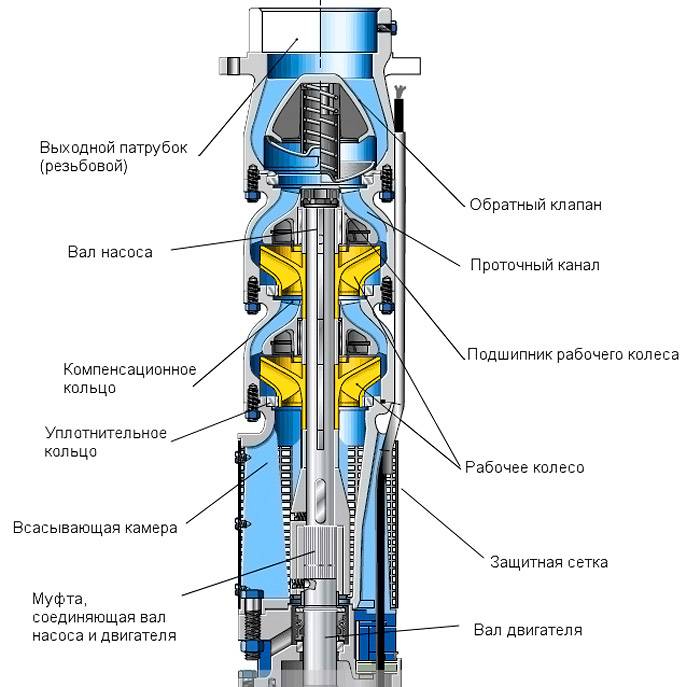
With a simplified version, the accumulator is not mounted. The control relay is adjusted so that the suction device is turned on when the tap is opened, and turned off when it is closed. Due to the lack of additional equipment, the system is more economical.
In such a scheme, the pump for the well should:
- ensure a high-quality rise of water directly to the highest point without any interruption;
- overcome without unnecessary difficulties the resistance inside the pipes that run from the well to the main points of consumption;
- create pressure in the places of water intake, which makes it possible to use various plumbing fixtures;
- provide at least a small operating reserve so that the well pump does not work at the limit of its capabilities.
With proper calculations, the purchased equipment will allow you to create a reliable system that provides water supply to the water intake points directly. The final result is issued immediately in three quantities, since any of them can be indicated in the technical documentation.
If the well can be used without a pump, then when operating the well, one cannot do without it. But well well - discord. And a completely logical question arises, but how to choose a pump for a well? This is due to the huge range of this type of product on store shelves. If the buyer does not have special knowledge, then this is a rather difficult task, since it is the pump that will ensure the uninterrupted supply of water to the household.
Well parameters
Before you go to the store or place an order on the Internet, you must accurately determine the following parameters in order to correctly calculate the pump for the well:
- the depth of the well (these data are entered in her passport, which is handed over to the owner after the work is completed);
- water quality in the well (the amount of impurities per 1 liter of water, data can be obtained from a specialized laboratory);
- well debit - the volume of water pumped per hour of work. (this parameter is necessary to select the pump power - it should not exceed the debit);
- distance from the water level in the well to the ground surface (measured independently using a weight on a string);
- distance from the point of water spill to the surface of the earth (this parameter is necessary to select a pump by power);
- well pipe diameter (these data are entered in the well passport, which is handed over to the owner after work is completed);
- the amount of water needed daily for household needs.
Calculation of a pump for a well
Choosing a pump or other equipment for a particular well is a very difficult task. It requires accurate engineering calculations based both on the parameters of the well itself and the volume of water consumption by the household, as well as those done using diagrams, formulas and tables. Only a system selected in this way and assembled by specialists autonomous water supply will be guaranteed to function even during maximum water consumption. An accurate engineering calculation will help you choose the type of pump for the well. Companies specializing in the construction of wells, as a rule, have these specialists in their staff.
An approximate independent calculation is also possible. It is produced according to two main parameters: pressure and flow. Consumption, or performance, is an indicator of the volume of water that a pump can pump per unit of time. The pressure is the height in meters to which the device is able to supply water. There are average rates of water per person per day - this is 1 cubic meter (washing, taking a bath, washing dishes, cooking, etc.). To calculate the water needs of one household, 1 m3 is multiplied by the number of people living in it. For example, for 3 people per day, 3 m3 of water will be enough. But the maximum indicator is also necessary, that is, if all households use water at the same time: the first uses a shower (10 l / min), the second washes dishes in the kitchen (6 l / min), the third flushes the toilet (6 l / min). Total - 22 l / min.
So, a family of three has 3 m3 of water consumption per day and maximum flow– 22 l/min. But this is only part of the expense, since in the summer it is necessary to water the plants on the site, fill the pool, wash the car and more. There is a certain average - 2 m3 per day. The total is: 5 m3 - daily water consumption. In order to determine the maximum pump pressure characteristic, it is necessary to increase the height of a particular house in meters by 6 meters and multiply by the pressure loss coefficient in an autonomous water supply system, equal to 1.15.
Suppose that the calculation is carried out for a 9-meter house: (9 + 6) * 1.15 = 17.25. This is the minimum pressure characteristic that a pump that provides water supply to the house must have. And this pump, which can deliver a pressure of at least 17.25, must provide a capacity of 1320 l / h (22 l / min). But that's not all. It is necessary to add to the calculated pressure the distance from the water surface in the well to the surface of the earth. Suppose this figure is 40 meters. Therefore, for this autonomous water supply system, it is necessary to install a pump with a pressure of 40 + 17.25 = 57.25, capable of delivering a capacity of at least 1320 l / h.
If the well is not near the house, but at some distance from it, in this case it must be understood that for every 10 meters of the water pipe running horizontally, about 1 meter of the pressure of the device is lost. That is, if the source of water supply is 50 meters away from the house, then the pump must have a pressure force: 57.25 + 5 = 62.25 meters. It is extremely important to correctly calculate the pressure characteristic, but the performance may be somewhat less, since the simultaneous use of water by all households is extremely rare. And the maximum flow in such a case can provide a hydraulic accumulator.
Pump types
Depending on the specific operating conditions, it is necessary to select pumps of the appropriate type:
- submersible;
- superficial;
- pumping stations.
How to choose a pump for a well from the proposed variety of types?
Surface pumps
Surface pumps are attractive because they have a low cost. This type of device is designed to work without immersion in liquid. They are not designed to raise water from great depths - the optimum is 7 meters. In order to increase the suction power, craftsmen resort to various tricks, for example, use an external ejector. In any case, with increasing depth, the performance of a surface pump decreases. And at a depth of 25 meters or more, prices for surface pumps no longer differ from more expensive types. But for work at a depth of up to 7 meters, such models are recommended, otherwise the water will be dirty.
Submersible pumps
These pumps operate with full or partial immersion in the water they are pumping. In this regard, materials that are not subject to corrosion are used in their production: stainless steel, waterproof composites, plastic and more. It cannot be said unequivocally that they should be used in wells, but the greater the depth, the more preferable it is to use this particular type of device. Basically, this type is divided into three large groups according to the method of pumping water: centrifugal, vortex and screw.
- centrifugal devices. They are used in cases where the water in the well contains a lot of sand (up to 180 g/m3). The pumps are equipped with special protection against serious damage in case they fail. Designed for pumping water from very deep wells. Fluid head in centrifugal pumps exceeds 100 meters. Main advantages: reliability and performance. These pumps are universal and are by far the most popular.
- Vortex devices. Designed to raise water from a depth of not more than 30 meters, but to a height of up to 100 meters. The pumps can pump liquids with a low sand content (up to 40 g/m3). The principle of operation of vortex pumps is that the functional wheel causes turbulence of water and thus pumps it. This type is recommended for wells with low water flow, as they are able to create sufficient pressure with a small flow of fluid. But the performance (flow rate) of vortex pumps is much lower than centrifugal ones.
- screw devices. Designed to lift water from a depth of no more than 15 meters to a height of up to 90 meters. They can work with water with a low admixture of sand (up to 40 g/m3). They are distinguished by low cost and the ability to work not only in wells, but in open water.
Pipes for the water supply system
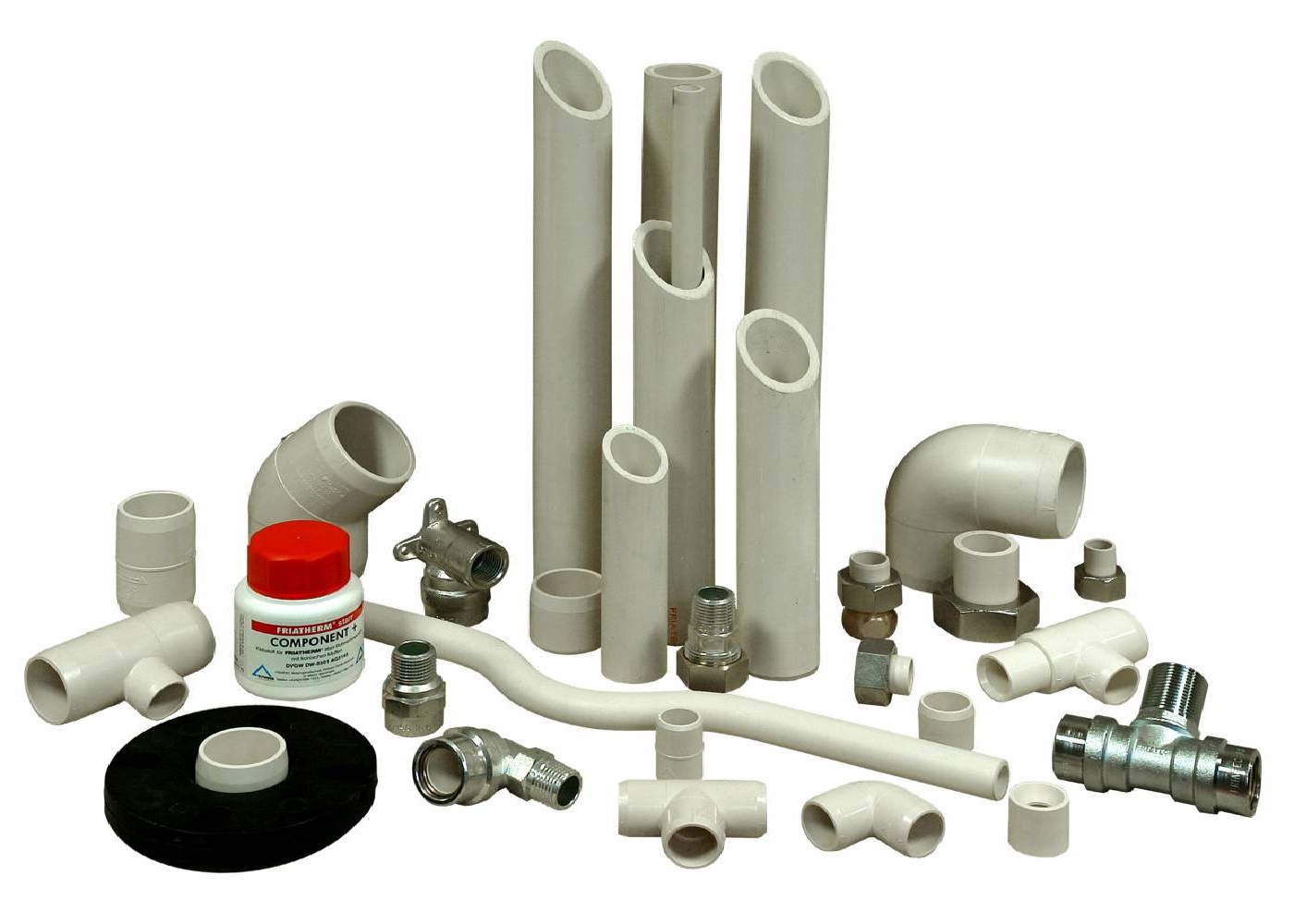
For the normal operation of the system, it is necessary to provide a high-quality piping system that can adequately pass water at a certain pressure, which creates specific model pump. Today, metal and polypropylene pipes are used. The latter are much lighter, more environmentally friendly, easy to transport and install, their connections are characterized by greater strength. disadvantages polypropylene pipes are: brittleness at low temperatures and the ability to work only with nominal pressure (it is indicated by the manufacturer in the passport).
What factors must be avoided when operating pumps
- Operation in the absence of water (the so-called "dry running") leads to overheating of the pump motor, since the pumped liquid also serves as a coolant. The same moment is also harmful for the sealant, which dries up without the passage of liquid through it.
- When the "dry pump" is turned on, a water hammer occurs. Residual fluid hits the blades hard and can damage them.
- When the “dry pump” is running, an air bubble can enter the water intake hose, which is also accompanied by water hammer.
- Freezing of liquids is unacceptable, this entails a serious breakdown of the device. If the pump is stored in an unheated room at temperatures below 0 degrees, all water must be drained and the device must be dried beforehand.
- Excess allowable temperature causes the engine to overheat.
- In no case should you save on pump power. Otherwise autonomous system the household water supply will not be able to flush the cleaning filters during regeneration.
- It is also worth remembering that some manufacturers in the instructions indicate the maximum parameters of the devices instead of working - nominal, which leads to low performance during operation.
After completing the process of drilling a well for high-quality water supply to a private house, it is necessary to decide on the purchase of a pump, this unit is the "heart" of the water supply system and not only the intensity and quality of water supply to the house, but also the health of the water supply system as a whole depends on its uninterrupted and well-coordinated work . So, how to choose the right well pump?
When choosing a pump, pay attention to specifications, but the most important guide should still be the well passport, which indicates the following parameters:
- optimal operating voltage;
- design;
- pressure indicator;
- depth;
- height difference and distance;
- static and dynamic water level;
- the size of the filtering part;
- performance indicator.
When choosing a pump, special attention should be paid to the distance from the filter to the water surface. This indicator should be more than 1 meter, otherwise there will be a risk of sanding the well.
Main types
Currently, there are only two types:
- Surface. It is rational to use such specimens if the water level does not reach 9 meters. Surface pumps can be installed on a floating platform or on the ground. Important: Avoid getting moisture inside the engine.
- Submersible. Pumps of this type are partially or completely immersed directly in water.
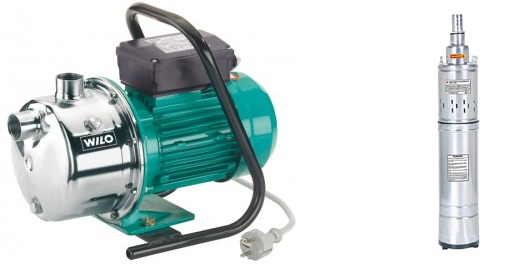
Submersible equipment, in turn, is classified into the following varieties:
- vortex pumps. Such units are intended for pumping water, which includes no more than 40 g/m of impurities. It is rational to use equipment of this category for wells, the depth of which varies from 30 to 100 meters.
- Centrifugal units- the most expensive. Experts recommend using equipment of this category for lifting water from a great depth (about 100 meters), while the proportion of sand in the water should not exceed 180 g / m.
- Screw pumps quite widely used in the process of organizing water supply from wells, the depth of which does not exceed 15 meters and reservoirs open type. Important: the content of impurities in water should be less than 40 g/m.
In order to determine the level of concentration of impurities in water, it is necessary to conduct a laboratory analysis.
There are also vibratory sediments, however, experts do not recommend installing this type of equipment in a well, since such a unit quickly becomes clogged with sand. Ideally, the performance of the pump should match that of the well itself. A situation is also acceptable when the pump is slightly weaker than the well (by 5-10%).
Power calculation
Building height + 6 m * 1.15 + indicator of the distance from the water level of the well to the surface of the earth.
Where, the value of 1.15 is the average coefficient of water head loss in the pipeline system. However, it is still better to entrust such an important matter to professionals.
In order for the water supply in the house to be uninterrupted, experts recommend installing automation. Perhaps the only disadvantage of the automatic converter is the high cost. Well, for places where there is no power supply, a good old hand pump will be an acceptable option.
Unfortunately, with no other type of pumps there are as many failures and failures as with domestic submersible well pumps. The reason is not in the quality of the equipment, but in the fact that the project and selection are carried out not by professional designers, but by the owners of private houses themselves or by insufficiently qualified personnel of installation organizations.
How, for example, does a non-specialist know that the engine of a pump selected with a large margin can burn out if the pump is not brought into the operating range during installation and configuration of the system.
We hope that this article will help readers avoid such mistakes.
Defining parameters
In all cases for right choice pump, first of all, it is necessary to determine its operating parameters - flow rate (Q) and head (H).The required water consumption is determined from the total productivity of all water points of the facility, taking into account the likelihood of their simultaneous use.
In a simplified calculation, you can use the following water consumption standards for plumbing fixtures:
- wash basin - 60 l/h, - flush tank toilet bowl - 83 l/h, - kitchen sink- 500 l/h, - shower - 500 l/h, - bathroom - 300 l/h, - watering tap - 1080 l/h.
Irrigation of lawns and flower beds requires 3-6 m3 of water per m2, while the consumption also depends on the irrigation method and irrigation intensity. Sauna or bath will require about 1000 l / h.
To calculate the required pressure, the formula is used:
Нtr \u003d Hgeo + S + Hsvob, where
Ngeo - the height of the pipeline input in the building relative to the dynamic water level in the well (the numerical expression of the dynamic level must be present in the well passport);
S is the sum of pressure losses due to friction in the pipeline and local resistances (fittings, fittings, filters, etc.);
Nsvob - the pressure that must be created at the entrance to the building, with the calculation of providing at the most remote and highly located water point of pressure of 0.5 atm.
Well parameters are of fundamental importance to the user, as they are used in calculating the required head and operating characteristic of the selected pump. In the well passport, drillers must indicate such parameters as static level, dynamic level, well flow rate. These data are determined experimentally by the organization that carried out the drilling. It is obvious that the results of the calculation will turn out to be incorrect if, when determining the dynamic level of the well, a pump of obviously lower power was used than is required to supply the facility with water in accordance with the consumer's requests. And although it is difficult for the user to count on a quick receipt of an official passport for an artesian well (this is a state document that requires many permits and approvals), it is necessary to require the provision of detailed data on the well along with the act of work performed, including inquiring about the power of the pump that was pumped out water when determining the dynamic level. When concluding a drilling contract, you should pay attention to the availability of a license from the contractor. Only serious firms always give the client a guarantee and a detailed well passport at the end of the work, where all the mentioned characteristics are clearly stated, as well as the diameter of the casing string, the list of soils passed, information about the test pumping of the well, etc. - up to the recommended brand of the pump and the depth of its installation.
The parameters of the required Q and H for additional equipment (jacuzzi, washer, sprinklers, "sprinklers", etc.) are indicated by the manufacturers. When installing water treatment filters, pressure losses (usually about 2 atm) and water consumption for washing them are taken into account. For the pool, only the time of its filling is indicated.
Calculation example
Initial data:Requires water supply suburban area With two-storey cottage(kitchen, two bathrooms and a hydromassage shower require a flow rate of 1 m3 / h and a pressure of 4-5 atm.), a garage, a house for staff (contains a bathroom), a bathhouse, a 45 m3 pool, irrigation of the territory, water treatment system. A family of four and two people from the staff permanently live on the site. A well 80 m deep was drilled for water supply of the site; casing string diameter - 150 mm; static level - 46 m; dynamic level - 50 m; flow measured during pumping - 3.5 m3/h.
Calculation:
Taking into account the norms of water consumption (see at the beginning of the article), we obtain the total consumption and pressure of consumers:
Qtot = 500 + 3 ґ (60 + 83 + 500) + 1000 + 1000 + 2 ґ 1060 = 6500 l/h = 6.5 m3/h
Ntr \u003d 50 + 8 + 20 + 2 + 30 \u003d 110 m
Due to the impossibility and inexpediency of using all draw-off points at once, the required flow rate can be determined as 5 m3/h.
The pump with (Q = 5 m3/h, H = 120 m) satisfies the calculated data; its characteristics are shown in fig. 1.
This ensures sufficient flow for the kitchen, one bathroom and watering. (It is understood that the owners will not simultaneously use a bath and take a bath, wash in the shower and fill the pool while watering the territory from both taps.) It is cheaper to use separate pumps to provide pressure on watering installations and hydromassage - this will allow you not to keep the entire water supply under high pressure and do the job submersible pump more stable, and the system flexible and independent (using additional pump you can always get high pressure at any point of parsing). The pool will fill up at night. At the same time, with the help of a valve on the head, the pump should be "throttled" (create additional resistance) so that when filling the pool, the flow does not exceed the allowable one - 6.5 m3 / h.
If the power is too high
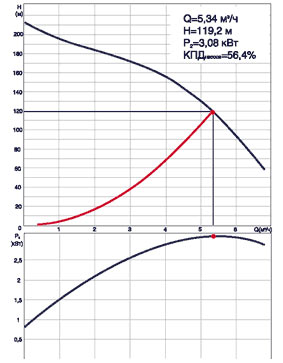
Fig.1. The performance characteristics of a properly sized pump.
Self-selection of the pump by the customer, who makes excessive demands on flow and head, often leads to the choice of the pump too high power. As already mentioned, when installing an overpowered model, complications are possible.
First, since at such a choice rated flow significantly exceeds the average water demand, the pump will operate in the mode of frequent on / off. Manufacturers allow up to 30 pump starts per hour, but only for one hour per day, with a general limit of 60 cycles per day. In any case, frequent switching on negatively affects the life of the electric motor and starting automation. To avoid this, you need to install membrane tank large volume.
Secondly, with an overestimated pump power, as a result, the water pressure at the entrance to the house will also be overestimated. At the moment of starting such a pump, strong hydraulic shocks will inevitably occur. Some fittings may simply not be designed for such pressure (dishwashers and washing machines, mixers), required additional installation pressure reducers to reduce pressure.
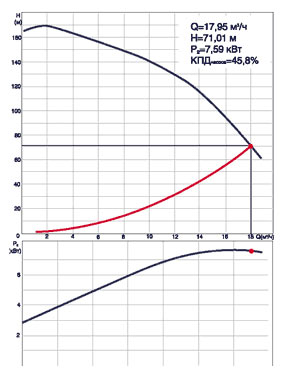
Fig.2. The pump is not correctly selected: the duty point is shifted to the right.
Thirdly, while filling the pool, the pump will work on " open pipe", without creating pressure. Under such conditions, there is a large flow of water at a minimum pressure. The operating point of the pump shifts on the characteristic curve to the right, to an area that does not correspond to working area pump (Fig. 2). The shaft power will be maximum, and at long work in this mode, the engine will fail.
The consequence of using a pump with oversized power will be a general rise in the cost of the entire system, caused by the use of more powerful electrical equipment, materials and fittings with a large allowable working pressure, an increase in the diameters of the pipeline and well, as well as an increase in the cost of water treatment.
If the nominal flow of the pump exceeds the flow rate of the well, it is necessary to install additional protection on a "dry run". Throttling and tuning the pump will lead to energy overruns.
In other words, while ensuring the possibility of simultaneous use of all water points by installing an oversized pump, the cost of the water supply system increases. In this case, the actual water consumption will be much less.
Therefore, although the final choice will always remain with the customer, it is cheaper and more correct to choose a pump based on real needs and with the help of specialists. It is possible to satisfy the user's requirements for the water supply system, subject to the rules for its installation and operation, by choosing the pump with a flat operating characteristic that is optimal in this situation.
For the water supply system from the above example, a pump can be selected (Fig. 1). In the area of possible flows (from 4 to 8 m3/h), this model has a flat head-flow curve, i.e. at low water flow rates, there will not be too much pressure increase. At the same time, some allowable margin when calculating water consumption will eliminate the possibility of water shortages.
Pump installation and commissioning
In any case, whichever pump is chosen, during installation it is necessary to align its operating point in all possible operating modes. During commissioning, the supplied flow rate (determined by the filling rate of any container of a known volume, such as a barrel), the pressure created (as indicated by the pressure gauge on the head) and the current consumed (measured with current tongs) should be measured.The obtained characteristics are compared with the passport data of the pump according to the catalog. If the operating parameters are exceeded (as a rule, a certain power reserve is provided, for example, for the subsequent installation of filters), it is necessary to close the valve at the outlet of the well, create additional local resistance sufficient to establish the correct operating point - the middle of the Q (H) characteristic.
Installation, as well as the selection of the pump, must be carried out by trained specialists, installation company must be licensed to install this equipment.
Well pump protection
Even before selecting and purchasing a pump, it is necessary to obtain accurate information about the power supply voltage at the site. This is especially important when choosing an imported pump. All equipment supplied from abroad meets, first of all, the industrial standards of the manufacturing country. So for all German pumps tolerance voltage in electrical network from the nominal is from +6 to -10%. Despite all the built-in protections, the pump is not designed to operate from a mains voltage below 200 V, all possible drawdowns and power surges will adversely affect the life of the electric motor. Here it is necessary to provide adjustable voltage protection as part of the control cabinet, and for three-phase pumps also from open-phase operating modes. It is not recommended to install powerful single phase pumps. The starting current of a 2.2 kW motor can exceed the rated current by 4.4 times! To stabilize the voltage within the operating range during such surges, you will need a stabilizer with a five-fold power reserve (more precisely, the choice will be made by stabilizer manufacturers). Sometimes it is cheaper for the user to provide a 380 V power supply at the site than to ensure the correct operation of a single-phase pump.According to statistics, about 85% of failures occur with the electrical part of the pump. The main reason is the interturn short circuit of the stator windings due to overheating due to hydraulic overload, or when operating at reduced or stepwise voltage. Both can be avoided by installing proper current protection. A conventional starter with current protection does the job quite well, but some installers forget to set it to the required current value. The result of such negligence is easy to calculate: you will have to pay for lifting the pump from the well, repairing it (the price of a new engine), for lowering the pump again and putting it into operation. The amount may exceed the cost of a new pump.








